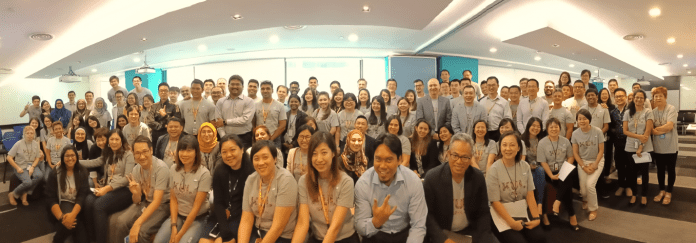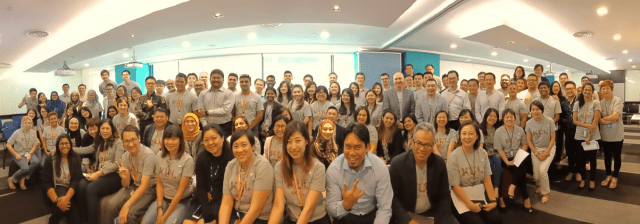Retaining employees, especially in key positions is vital to the success and holistic health of businesses. Today more than ever, organisations are increasingly looking towards employee experience as one of the vital building blocks towards customer satisfaction.
In an economic environment encompassing so many different industry verticals, there are undeniably ‘hot’ sectors which see businesses compete fiercely for talent. This is especially true in finance and technology, where employers are finding it increasingly difficult to both attract and retain talent.
The Oxford Economics Workforce 2020 Survey, which polled more than 5000 executives and employees in 27 countries across the Asia region, found 64 percent stating that Millennials entering the workforce will have a major impact on their firm’s workforce strategy. Yet at the same time, only 27 percent said they are giving special attention to those wants and needs.
To see what some companies are doing to resolve this crisis, we spoke to Duncan Williamson, Managing Director of SAP Malaysia. According to Williamson, SAP constantly aims to be an employer of choice for the current and future generation workforce.
As a little bit of background, SAP is a global brand which serves more than 378,000 customers across over 180 countries today. 80 percent of SAP customers are SMEs, although it also includes 91 percent of Forbes Global 2000 companies. SAP works with almost all of the world’s 100 most valued brands.
Combined, SAP customers produce 78 percent of the world’s food and 82 percent of the world’s medical devices. In fact, more than three quarters of the entire world’s transaction revenue is said to touch an SAP system.
On the workplace front, SAP has received many awards for being an awesome place to work.
“Our secret is a culture that lets our employees shine,” reveals Williamson.
The company’s latest recognition from industry is the “Best Employer Brand Award” supported by the Malaysian Institute of Human Resources Management for efforts to attract, retain and develop talent (pic below). This achievement follows on from SAP having been named one of Asia’s Best Multinational Workplaces in 2018 by the Great Place to Work (GPTW) Institute.
Building Talent on Strong Foundations
SAP leans on three key pillars of truth in its approach towards employees: Investment in youth for the future, Diversity and Learning as a foundation for success.
“As a business what we really want to improve on are engagement and retention. We look towards creating a healthy environment where employees are empowered to play strong roles in helping our customers succeed. Of course, when we say healthy, this replies to their physical and emotional wellbeing too,” says Williamson.
This comes under a philosophy which Williamson describes as being “performing people and impacting lives, while fulfilling our capability and to overachieve what we set out to do.”
The company is a great place for young people to work in, particularly those with ambition and an entrepreneurial mindset. Through these youth, SAP aims to develop the skillsets necessary for a strong ecosystem to build the next generation of business leaders.
As a global company and employer, SAP has a very diverse and inclusive culture. This is another key theme that makes it such an attractive place to work. The company believes that this very diversity is a source of strength in meeting customer needs.
Finally, for SAP, education and learning always goes past formal means. The company strongly believes that learning happens all the time and in many ways. They have worked hard to build a global “Learning Culture” where all staff can be both student and mentor.
Good organisations often create a culture or environment which strongly reflects their values. Employers such as SAP recognise that how they treat their employees is a large part of the company’s overall success.
The company also has a strong focus in Southeast Asia, with a presence in 7 countries and already serving 92 out of 100 top ASEAN companies. With a workforce more than 3,500 strong across the region, SAP sees 12,000 students undergo the SAP curriculum every year.
Developing a Holistic Leadership Pool
Yet the success of a company also lies in the ability of its leadership to guide it through many different scenarios of growth. As an aspiring employer of choice, SAP has also taken this into account and tried to develop future talent from within.
“Through a thorough talent and succession management process, we work to identify successors for key positions, then provide them with the proper coaching and support to take on additional responsibility,” said Williamson.
“For example, these potential leaders may be asked to participate in a wide range of development experiences and programs which would include material that is customized to their experience levels,” he adds.
One such programme, Managing People@SAP, introduces first-level leaders to the basics of leadership and management. As members go through the courses, they are also subject to detailed input from fellow participants and other colleagues, aimed at helping them grow to their best ability.
By tapping into people’s passions, such as in sustainability and corporate responsibility, the company tries to foster a vision towards helping improve people’s lives. This concerted effort towards sustainability is one of the cores which supports the overall business strategy at SAP.
Aside from internal programs, the company also offers a social sabbatical. This short-term assignment helps selected top talents realise satisfaction in helping small businesses and entrepreneurs in emerging markets solve business and social challenges.
“Still, the process is constantly under development. We conduct an employee survey every year where we gather insights from all employees to better understand how we can better engage them and improve how we do things as a company,” he said.
On Women in IT
As a company with a true workforce of the future, SAP has been making great strides in the Asia Pacific and Japan region towards increasing the number of women in the workforce.
“Our numbers have been increasing every year, from 22 percent in 2013 to 25 percent in 2015. In fact, our Singapore office has done remarkably well, and we are now seeing a 44 percent female workforce which contributes to 25 percent of our leadership team there,” said Williamson.
As the company grows even further in the region, Williamson sees their workforce growing in tandem. By ensuring support for people through the right learning and development tools, SAP is confident that they will not be a part of limiting women’s participation.
“It all boils back down to diversity. As mentioned earlier, we believe that diversity has played a large part in our success, so why would be put any barriers on half of the world’s potential workforce? At a macroeconomic level, a women-inclusive society will plug talent gaps and raise competitiveness, which is a good thing,” he said.
The SAP “Future of Work” Model
With such keen focus on employee empowerment and education, it is obvious that SAP is seriously committed towards meaningful engagement with its staff. To do this on a global scale efficiently, the company has in place several core initiatives built around career and leadership development, social responsibility and most importantly, people sustainability.
These include a wide range of benefits and programs which include focused investment in training and development, extended parental leave and health and wellness programs.
Flexibility – SAP employees have the freedom to explore diverse career paths in a variety of positions in SAP offices around the world. This, coupled with flexible working hours allowing their people around the globe to work anytime, anywhere, supports the human element and fits the profile of Millennials today. By offering a wide range of flexible working models, the company itself is also catering to the natural needs of people as they grow through different phases in life.
Health and Wellness – SAP has a whole has invested deeply into a holistic and comprehensive program that is designed to promote the wellness of its employees. This is more than merely the physical health of its employees but looks past that towards the creation of a healthy work environment. According to Williamson, SAP offers a host of health programs in numerous locations throughout the world to address the range of needs of employees who have sedentary, highly demanding intellectual jobs –from physical well-being to stress management and leadership workshops.
Support Through Resources – Modern office environments, the latest in technology and of course, running SAP solutions such as SAP SuccessFactors helps SAP employees perform at their best.
“People are our #1 asset at SAP and we invest heavily in our people in all respects – from their professional development to helping them build a holistic lifestyle. In order to do this, we feel that as an employer we need to give them the right tools and resources to do so,” said Williamson.
Building Success Through SuccessFactors
With such a strong and all-encompassing view of how important their employees are, it comes as no surprise that SAP runs SAP; SuccessFactors HCM Suite. The SAP SuccessFactors Human Capital Management solution comines almost all aspects of employee management, from onboarding to HR analytics.
Through SucessFactors, SAP can deliver quickly and capably on business strategy alignment, team execution and maximize people performance. Thanks to it being a cloud-based, easy to implement solution, SuccessFactors also means that SAP can growing with itself anytime and to any scale.
SAP SuccessFactors provides rapid results, allows for continuous innovation, enables HR to access information across countries, improves HR decision making, and can handle multiple currencies and languages.
In fact, so potent is the SuccessFactors suite that Gartner researchers have rated SAP SuccessFactors above average for breadth, depth and customer adoption across all functions (4.4); native capabilities bolstered by acquisitions and continued development (4.0); and availability of options to extend delivered functionality and favourable feedback on user experience (3.8), among others.
“They say that the proof is in the pudding, but to us at SAP, excellence is a lifelong journey. Along the way, we have ably satisfied the requirements of customers with complex requirements requiring the capabilities of SAP SuccessFactors,” he added.
The Next Generation Workforce
Talent is one of the key cornerstones in today’s economy and traditional methods of attracting, hiring, and retaining employees with the right skills and competencies can no longer be adequately relied on.
Technology as drastically impacting how not only existing staff, but also potential employees interact with organizations. There is a growing expectation of automated and agile systems that cover the breadth of the HR process, yet this is still lagging on lagging on many fronts.
“The solution lies quite starkly in front of our faces to be honest and we’re actually quite certain a growing number of employers realise this too. The biggest challenge that many of them face is no doubt finding the right partners that will enable HR to deliver strategic value through digital transformation,” concludes Williamson.
They say that one cannot argue with success and there is no doubt that as an employer of choice, SAP has been overwhelmingly successful here in Malaysia and on a global scale.
Recognised in multiple countries around the globe, the company continues its headlong journey towards excellence, with thousands of inspired employees joining them along the way.











